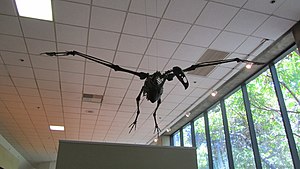Teratornithidae
| Teratornithidae | ||||||||
|---|---|---|---|---|---|---|---|---|

Skeleton of Teratornis merriami in the La Brea Tar Pits Museum |
||||||||
| Temporal occurrence | ||||||||
| upper Oligocene to Pleistocene | ||||||||
| 25 to 0.126 million years | ||||||||
| Locations | ||||||||
| Systematics | ||||||||
|
||||||||
| Scientific name | ||||||||
| Teratornithidae | ||||||||
| LH Miller , 1909 |
The Teratornithidae are a family of giant, vulture-like birds that were found in North and South America from the Late Miocene to the Pleistocene . As far as we know, Argentavis magnificens is the largest flight bird that has ever lived, one of the Teratornithidae. They were formerly part of the New World Vultures as the subfamily Teratornithinae . Since the morphological differences to the New World vultures are just as great as those between most of the bird families belonging to one order, they are now regarded as a separate family. In addition to the New World vultures, the Teratornithidae also have something in common with the storks and the coarse pods .
The Teratornithidae probably developed in the westerly wind zone of the late Miocene in southern South America, which then extended further north than it does today, as the southern Andes were not yet that high. Campbell and Tonni suspect that because of their beak anatomy they were unable to tear pieces of meat from carcasses and that, like owls , they devoured small, self-captured prey whole. Most scientists, however, see them as scavengers who, similar to today's vultures, sailed for carrion across open grasslands . When the Panama land bridge was built three million years ago , the Teratornithidae also colonized North America as part of the great American faunal exchange.
Genera
The best-known genus of Teratornithiden is Teratornis from North America, which had a wingspan of 3.5 to 3.8 meters and was 75 centimeters high when seated. Of this genus, the fossil remains of over 100 specimens have been found in the tar pits of La Brea . Argentavis had a wingspan of 7 to 7.5 meters and was 1.5 meters high. Its weight is estimated at 72 kg. He lived in the late Miocene and Pliocene in South America. Fossils have been found in Argentina. Two other genera, Aiolornis and Cathartornis, are known only from a few bones. Aiolornis had a wingspan of five meters and a particularly large beak. He lived in North America. Cathartornis is only known from the La Brea tar pits. In 2002 the existence of the Teratornithidae was extended far downwards by the discovery of the oldest teratornithid Taubatornis campbelli from the Upper Oligocene of São Paulo (Brazil). Taubatornis was much smaller than other genera in the family and shows many similarities with New World vultures.
swell
- Alan Feduccia : The Origin and Evolution of the Birds. 2nd ed., Yale University Press, New Haven / London 1999, ISBN 0300078617 .
Individual evidence
- ↑ Kenneth E. Jr. Campbell, & EP Tonni, (1983): Size and locomotion in teratorns. The Auk 100 (2): 390-403, PDF .
- ↑ Kenneth E. Jr. Campbell, E. Scott & KB Springer (1999): A new genus for the Incredible Teratorn (Aves: Teratornithidae). Smithsonian Contributions to Paleobiology 89: 169-175. ( PDF , 128 MB!)
- ^ SL Olson & HMF Alvarenga. 2002: A new genus of small teratorn from the Middle Tertiary of the Taubaté Basin, Brazil (Aves: Teratornithidae). Proceedings of the Biological Society of Washington 115 (4): 701-705 PDF